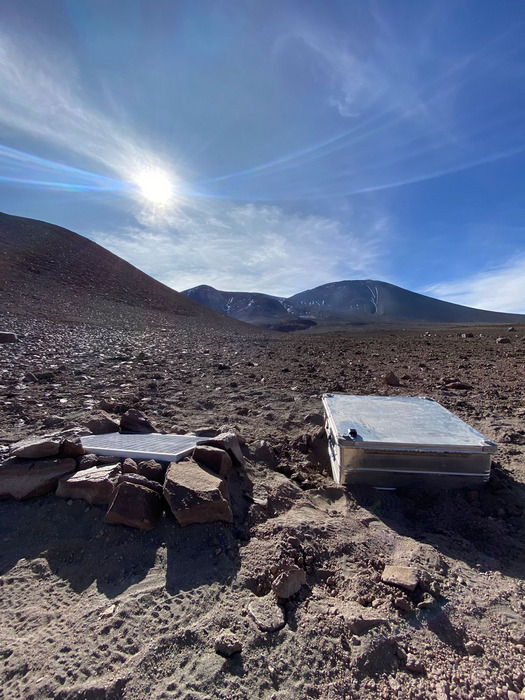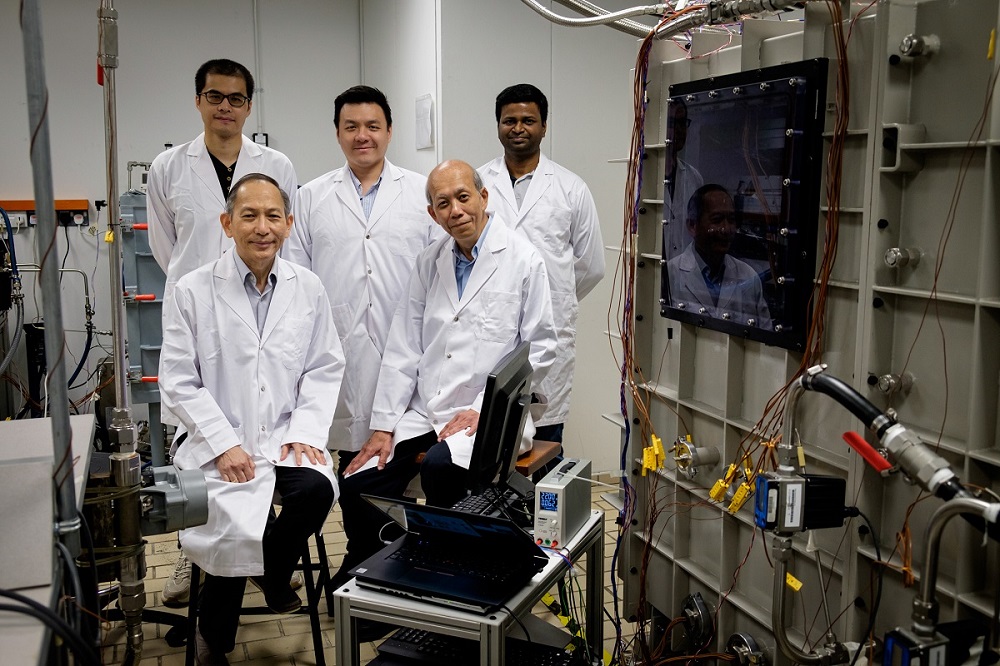
The SO2 camera installation on Lascar Volcano, Chile. The camera is housed inside a protective metal casing, which also holds the battery for powering the instrument; a solar panel for battery charging is located to the left of the box.
CREDIT: Dr Thomas Wilkes
Scientists make long-term volcano monitoring feasible by developing a camera that is cheaper and more efficient in the field
Gas emissions are the manifestation of activity occurring beneath the surface of a volcano. Measuring them lets researchers see what can’t be seen from the surface. This knowledge is vital for hazard monitoring and the prediction of future eruptions. Since the mid-2000s, ultraviolet SO2 cameras have become important tools to measure emissions. The measurement campaigns, however, must be accompanied by a user, making SO2 cameras unsuitable for acquiring long-term datasets. Building and operating this type of camera can cost upwards of $20,000, resulting in very few cameras being installed permanently.
To get better long-term monitoring data, an international team of researchers has developed an SO2 camera to continually measure emission rates from volcanoes. They have now published an article about the camera design and two initial datasets in Frontiers in Earth Science.
“Our instrument uses a sensor not dissimilar to smartphone camera sensors. It is modified to make it sensitive to ultraviolet light, therefore enabling SO2 detection,” said Dr Thomas Wilkes, a researcher at the University of Sheffield and lead author of the study.
Less costly and power intensive
Compared to previous models, the researchers’ SO2 camera is significantly cheaper and uses less power. The new design comes with a price tag of around $5,000, reducing the cost of parts needed to build the camera down to approximately a fourth of previous models.
“Wherever possible we 3D print parts too, to keep costs as low as we can,” Wilkes explained. “We also introduce a user-friendly, freely available software for controlling the instrument and processing the acquired data in a robust manner.” The affordability and user-friendliness makes the camera accessible to more volcanologists who otherwise might not have access to datasets containing accurate gas emission rates.
Additionally, the power consumption of the system is low, with an average of 3.75 Watts. This is about half of what was needed to power systems presented previously. On sites where there is little solar power to be harnessed this will be especially beneficial, the researchers wrote. Their camera runs on fewer or smaller solar panels or batteries, reducing the overall cost further.
While there are other instruments to measure volcanic emissions, “the SO2 camera can provide higher time- and spatial-resolution data which could facilitate new volcanological research when installed permanently,” said Wilkes.
Data from Chile and Hawaii
Wilkes and his team also presented two preliminary data sets from Lascar, a stratovolcano in Chile, and Kilauea, a shield volcano on Hawaii’s Big Island, where their camera is in continuous operation.
“Before now, only three volcanoes have had permanent SO2 cameras installed on them,” Wilkes said. “Discrete field campaigns have been carried out, and whilst they can be invaluable for a range of research questions, it is important to be able to measure volcanic activity continuously, since it can vary substantially from minutes to decades to centuries and beyond.”
Despite being cost-efficient and easy to use, the researchers pointed to some limitations of SO2 cameras: “They are dependent on meteorological conditions, and work best under clear blue skies when the volcanic gas plume moves in a 90-degree angle to the viewing direction of the camera,” said Wilkes.
Original Article: New low-cost camera could help scientists forecast volcano eruptions affecting millions
More from: University of Sheffield
The Latest Updates from Bing News
Go deeper with Bing News on:
Volcano monitoring
- No casualties in one of Indonesia’s biggest volcanic eruptions in 50 years. What lessons does it offer in disaster preparedness?
All 838 locals on tiny Ruang island evacuated before rescue teams arrived. Their disaster preparedness offers valuable lessons to others in volcanic areas, experts say.
- How deep the volcanic tunnels go into the earth, know what harm it will cause
Volcanic tunnels, also known as lava tubes, are intriguing geological formations that captivate the imagination of both scientists and adven..|News Track ...
- Volcano Watch — Introducing HVO’s new online eruption map
Volcano Watch is a weekly article and activity update written by U.S. Geological Survey Hawaiian Volcano Observatory scientists and affiliates. This week’s article is by HVO geologist and GIS analyst ...
- Ash Shrouded Skies: Powerful Volcanic Eruption at Mount Ruang
A powerful volcanic eruption lofted ash high into the atmosphere and spread tephra and other volcanic debris across the small island in Indonesia. Ruang is a small volcanic island in the Sangihe ...
- Iceland Volcano Eruption: Scientists Issue Urgent Lava Warning
The Icelandic Meteorological Office has warned that increased pressure and ground lift has been noted beneath Svartsengi on the Reykjanes Peninsula.
Go deeper with Bing News on:
SO2 camera
- A laser-based air quality monitor on every lamp post?
An EU-funded project called PASSEPARTOUT is developing a new gas-sensing network that can analyse multiple gasses in real-time. The system is sufficiently compact (‘hand sized’) and affordable (sub ...
- Earth Day 2024: Promoting Sustainability with Extended Device Lifespan
As Earth Day approaches, individuals and businesses alike are turning their focus towards sustainable practices that can help protect our environment – as many as 87% of business leaders say that ...
- 12K homes, 15 towers
The future of Burnaby’s Metrotown is on display in a new public engagement website by developers seeking feedback on one of the most important master plans in the city.









